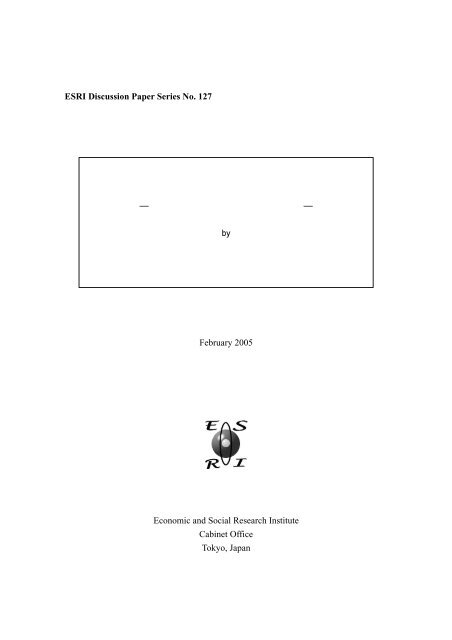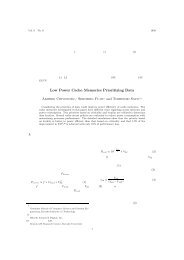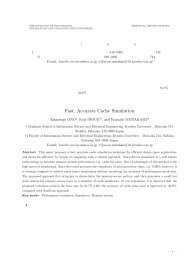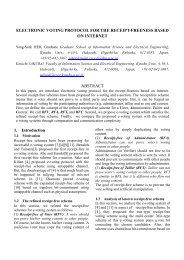ESRI Discussion Paper Series No. 127 企業の組織的・人 ... - 九州大学
ESRI Discussion Paper Series No. 127 企業の組織的・人 ... - 九州大学
ESRI Discussion Paper Series No. 127 企業の組織的・人 ... - 九州大学
You also want an ePaper? Increase the reach of your titles
YUMPU automatically turns print PDFs into web optimized ePapers that Google loves.
<strong>ESRI</strong> <strong>Discussion</strong> <strong>Paper</strong> <strong>Series</strong> <strong>No</strong>. <strong>127</strong>byFebruary 2005Economic and Social Research InstituteCabinet OfficeTokyo, Japan
*****shino@en.kyushu-u.ac.jp1
3141 JEL D21, L25, O122
How Does Information Technology Pay Off ?Firm-level Evidence in Organizational Structures and Human Resource ManagementAkihiko Shinozaki *[Abstract]The purpose of this study is to investigate how corporate reforms in organizational structures andhuman resource management affect the effective use of information technology based on thenation-wide survey data from 3141 firms. Multiple comparison analysis revealed four observations.First, reforms in organizational structures and human resource management significantly affect theeffectiveness of information technology. Second, small size firms have difficulties on humanresource management in their use of the technology. Third, some industries such as medical serviceand education are less enthusiastic to effective use of information technology. Fourth, heavy users ofinformation technology are located in Tokyo Metropolitan, but they are not always successful in the“effective” use of the technology due to the mismatch of corporate reforms.Keywords: Information Technology, Corporate Reforms, Organizational Structures, HumanResource Management, Firm Size, Regional Differences, Japanese Industry.JEL Code: D21, L25, O12*Kyushu University, Japan (shino@en.kyushu-u.ac.jp).3
I3 15 71 3141 4 5 9 27 (1)(2) (3)II3 2 Games-Howell 9 (1)4 (2)3 4 (3)8 III4
IV5
15 2003 3 319500 4491 71 31411980 11990 1990 23 Hammer(1990)Brynjolfsson, et al.(2002) 4 53 1(2003)3 Dedrick, et al.(2003)2 Brynjolfsson=Hitt(1996, 2000), Oliner=Sichel(2000), Jorgenson(2001), Baily(2002), Stiroh(2002)3 Stiroh(2002), pp.1559-1560 4 (2004), (2004), (2004), (2003)5(2000), (2004)6
64 71 5 9 27424 15 (a)(b)(c)(d)4 71 ()()2 3 Games-Howell 9 4 3 4 18 26(2002)7
7(1) ln(V/L)=α+β ln(K/L)+γITscore (2) ln(V/L)=α+β ln(K/L)+γ 1 D 1 +γ 2 D 2 +γ 3 D 3 +γ 4 D 4 +γ 5 D 5 +γ 6 D 6 +γ 7 D 7 VLKITscoreD i 4 9500 4491 71 (a)(b)(c)(d)4 10 (a) 1 21 34LAN 24 3913 (b) 2 123 9 10 19 4028 7IIV IVIII 8
(c) 3 123 83729 (d) 4 732 A B C D 5 20 4103 3141 1 3 3141 (1)(2) (3) 3 300 1000 1003000 5 28 9 327 125 39 30 1003836 43 941378211095 257983 12556 2929171 93 507 323 325 28 1411989
4300 1000 Tukey 88 Tukey Tukey-Kramer 10
58 2 8 5 6 8 5 4 32 11
6351 140 26 24 18 16 14 11 11 8 8 25 11 11 11 10 10 34 4 23 15 11 351 18 14 12
I II III IV 4 7 I III II IV III II I IIIIV8I III II IV IIIII 3 I II III IV VVI VII VIII 8 13
9 I VIII 2 IIIII V 2.52.72.4 1 IV VI VII 3.22.93.1 IV II V VI IIIV VI VII IV VI VII V IVIII 3 IVVIIVIII IV 4IV VIII III IV 14
I VIII 5VIII I 434 10 434 I VIII 434 3141 I VIII 28 3 3141 28 18434 I VIII (1) ln(V/L)=α+β ln(K/L)+γITscore (2) ln(V/L)=α+β ln(K/L)+γ 1 D 1 +γ 2 D 2 +γ 3 D 3 +γ 4 D 4 +γ 5 D 5 +γ 6 D 6 +γ 7 D 7 VLKITscoreD[D 1 :HHH, D 2 :HHL, D 3 :HLH,D 4 :HLL, D 5 :LHH, D 6 :LHL, D 7 :LLH, H L ](1) ln(V/L)=1.0610.654 ln(K/L)0.055 ITscore(1.693) (10.555)*** (2.036)*adjR 2 =0.286, n=424, ( )t [***
(1)(2) VIII VII D 2 434 3141 71 3141 IIV IVIII 16
Baily, Martin Neil. 2002. “The New Economy: Post Mortem or Second Wind?” Journal of EconomicPerspectives. Spring 2002, 16:2, pp. 3–22.Brynjolfsson, Erik and Lorin Hitt. 1996. “Paradox Lost?: Firm-level Evidence on the Returns toInformation Systems Spending.” Management Science. April 1996, 42:4, pp. 541–558.Brynjolfsson, Erik and Lorin Hitt. 2000. “Beyond Computation: Information Technology, OrganizationalTransformation and Business Performance.” The Journal of Economic Perspective. Fall 2000, 14:4,pp. 23–48.Brynjolfsson, Erik and Lorin Hitt. 2003. “Computing Productivity: Firm-level Evidence.” The Review ofEconomics and Statistics, Vol. 85, <strong>No</strong>. 4, pp.793-808.Brynjolfsson, Erik, Lorin Hitt, and Shinkyu Yang. 2002. “Intangible Assets: Computers andOrganizational Capital.” Brookings <strong>Paper</strong>s on Economic Activity, 1:2002, pp.137-198.Dedrick, Jason, Vijay Gurbaxani, and Kenneth L. Kraemer, 2003, “Information Technology andEconomic Performance: A Critical Review of the Empirical Evidence.” ACM Computing Surveys, Vol.35, <strong>No</strong>. 1, pp.1-28.Jorgenson, Dale W. 2001. “Information Technology and the U.S. Economy.” American Economic Review.March 2001, 91:1, pp. 1–32.Oliner, Stephen D. and Sichel, Daniel E. 2000. “The Resurgence of Growth in the Late 1990s: IsInformation Technology the Story?” Journal of Economic Perspectives. Fall 2000, 14:4, pp. 3–22.Stiroh, Kevin J. 2002. “Information Technology and the U.S. Productivity Revival: What Do the IndustryData Say?” American Economic Review.92:5, pp. 1559–1576., 2003.. , 2004.SPSS Amos ., 2000., 2000 10 ., 2002., , pp.1-16. , 2003.. , 2004.11 ., 2004.., 2004.1315 , 2004 3 .17
IV III II I IV III II I VIII VII VI V IV III II I 3,141 0.0 10.0 5.375 2.3507 0.04193,141 0.0 10.0 1.238 1.5370 0.0274 (3,141) (0.0) (5.0) (0.762) (0.9556) (0.0171) (3,141) (0.0) (5.0) (0.476) (0.7563) (0.0135)3,141 0.0 10.0 2.812 2.5437 0.04543,141 0.0 10.0 2.664 1.9015 0.033922
100 768 100 300 1031 300 1000 799 1000 3000 366 3000 177 3141 123204444706420 126 68 147 903 314123
3141 31
434 34















